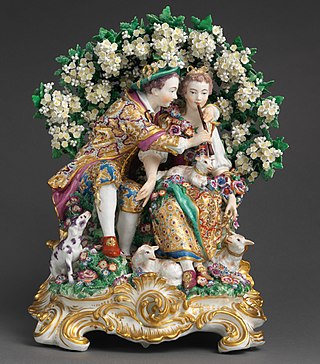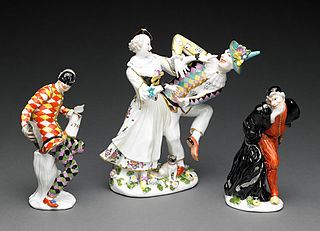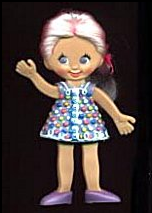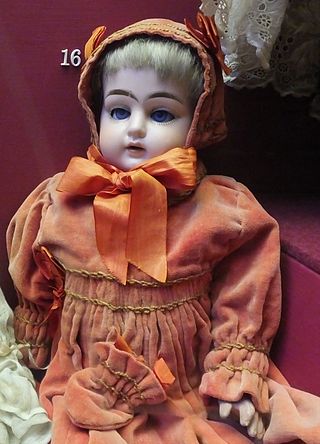
A doll is a model typically of a human or humanoid character, often used as a toy for children. Dolls have also been used in traditional religious rituals throughout the world. Traditional dolls made of materials such as clay and wood are found in the Americas, Asia, Africa and Europe. The earliest documented dolls go back to the ancient civilizations of Egypt, Greece, and Rome. They have been made as crude, rudimentary playthings as well as elaborate art. Modern doll manufacturing has its roots in Germany, from the 15th century. With industrialization and new materials such as porcelain and plastic, dolls were increasingly mass-produced. During the 20th century, dolls became increasingly popular as collectibles.

Porcelain is a ceramic material made by heating raw materials, generally including kaolinite, in a kiln to temperatures between 1,200 and 1,400 °C. The greater strength and translucence of porcelain, relative to other types of pottery, arise mainly from vitrification and the formation of the mineral mullite within the body at these high temperatures. End applications include tableware, decorative ware such as figurines, and products in technology and industry such as electrical insulators and laboratory ware.

Chelsea porcelain is the porcelain made by the Chelsea porcelain manufactory, the first important porcelain manufactory in England, established around 1743–45, and operating independently until 1770, when it was merged with Derby porcelain. It made soft-paste porcelain throughout its history, though there were several changes in the "body" material and glaze used. Its wares were aimed at a luxury market, and its site in Chelsea, London, was close to the fashionable Ranelagh Gardens pleasure ground, opened in 1742.

Biscuit porcelain, bisque porcelain or bisque is unglazed, white porcelain treated as a final product, with a matte appearance and texture to the touch. It has been widely used in European pottery, mainly for sculptural and decorative objects that are not tableware and so do not need a glaze for protection.

Meissen porcelain or Meissen china was the first European hard-paste porcelain. Early experiments were done in 1708 by Ehrenfried Walther von Tschirnhaus. After his death that October, Johann Friedrich Böttger continued von Tschirnhaus's work and brought this type of porcelain to the market, financed by Augustus the Strong, King of Poland and Elector of Saxony. The production of porcelain in the royal factory at Meissen, near Dresden, started in 1710 and attracted artists and artisans to establish, arguably, the most famous porcelain manufacturer known throughout the world. Its signature logo, the crossed swords, was introduced in 1720 to protect its production; the mark of the swords is reportedly one of the oldest trademarks in existence.

Mintons was a major company in Staffordshire pottery, "Europe's leading ceramic factory during the Victorian era", an independent business from 1793 to 1968. It was a leader in ceramic design, working in a number of different ceramic bodies, decorative techniques, and "a glorious pot-pourri of styles - Rococo shapes with Oriental motifs, Classical shapes with Medieval designs and Art Nouveau borders were among the many wonderful concoctions". As well as pottery vessels and sculptures, the firm was a leading manufacturer of tiles and other architectural ceramics, producing work for both the Houses of Parliament and United States Capitol.

Sprigging or sprigged decoration is a technique for decorating pottery with low relief shapes made separately from the main body and applied to it before firing. Usually thin press moulded shapes are applied to greenware or bisque. The resulting pottery is termed sprigged ware, and the added piece is a "sprig". The technique may also be described by terms such as "applied relief decoration", especially in non-European pottery.

"Parian" is a term misapplied to a type of bisque shoulder head dolls manufactured primarily in Germany in the last quarter of the 19th century, from around 1860 to 1880. The origin of the term "parian" comes from the white marble from the island of Paros. The proper descriptive term for these dolls is "bisque". These shoulder head dolls have a body made from fabrics and a head created from very lightly tinted or untinted white porcelain. Unlike the china doll however, the bisque doll's head is not dipped in glaze before firing and as such has a matte finish, giving it a markedly different appearance. The UFDC still perpetuates the incorrect definition of these dolls is as follows: "Parian doll: doll made of fine white bisque without tinting. The features, hair and cheeks may be painted." Many collectors now are discarding the term parian in favor of untinted bisque versus tinted bisque.

Pierre-François Jumeau, was the founder of Jumeau. Jumeau was an 1840s French firm that produced bisque dolls and china dolls. His second son Emile-Louis Jumeau, born in 1843, began assuming management of the company in the 1870s.

Flatsy Dolls are flat dolls that were made by Ideal Toy Company from 1969 through 1973. Designed by Hank Kramer, Flatsy Dolls were originally marketed to little girls. Like many vintage dolls, Flatsy dolls are now collectors items.

A Frozen Charlotte is a specific form of china or bisque doll made in one solid piece without joints from c. 1850 to c. 1920. They were typically inexpensive, and the name Penny doll is also used, in particular for smallest, most affordable versions. The dolls had substantial popularity during the Victorian era.
Mildred Seeley was a doll collector, doll-related entrepreneur, and prolific author on the subjects of doll making and doll collecting.

A bisque doll or porcelain doll is a doll made partially or wholly out of bisque or biscuit porcelain. Bisque dolls are characterized by their realistic, skin-like matte finish. They had their peak of popularity between 1860 and 1900 with French and German dolls. Bisque dolls are collectible, and antique dolls can be worth thousands of dollars. Antique German and French bisque dolls from the 19th century were often made as children's playthings, but contemporary bisque dolls are predominantly made directly for the collectors market.

The Royal Porcelain Factory in Berlin, also known as the Royal Porcelain Manufactory Berlin and whose products are generally called Berlin porcelain, was founded in 1763 by King Frederick II of Prussia. Its actual origins, however, lie in three private enterprises which, under crown patronage, were trying to establish the production of "white gold" in Berlin from the mid-18th century onwards.

A composition doll is a doll made partially or wholly out of composition, a composite material composed of sawdust, glue, and other materials such as cornstarch, resin and wood flour. The first composition dolls were made in the 19th century.

Kewpie is a brand of dolls and figurines that were conceived as comic strip characters by cartoonist Rose O'Neill. The illustrated cartoons, appearing as baby cupid characters, began to gain popularity after the publication of O'Neill's comic strips in 1909, and O'Neill began to illustrate and sell paper doll versions of the Kewpies. The characters were first produced as bisque dolls in Waltershausen, Germany, beginning in 1912, and became extremely popular in the early 20th century.

Simon & Halbig was a doll manufacturer known for bisque doll heads with subtle colouring. They were based in Thuringia, the centre of the German doll industry. They supplied doll heads to many other well known doll makers. These are now collectables.

Armand Marseille was a company in Köppelsdorf, Thuringia, Germany, that manufactured porcelain headed (bisque) dolls from 1885 onwards.

Ernst Heubach was a company in Köppelsdorf, Thuringia, Germany, that manufactured porcelain-headed bisque dolls from 1885 onwards

China painting, or porcelain painting, is the decoration of glazed porcelain objects, such as plates, bowls, vases or statues. The body of the object may be hard-paste porcelain, developed in China in the 7th or 8th century, or soft-paste porcelain, developed in 18th-century Europe. The broader term ceramic painting includes painted decoration on lead-glazed earthenware such as creamware or tin-glazed pottery such as maiolica or faience.






















